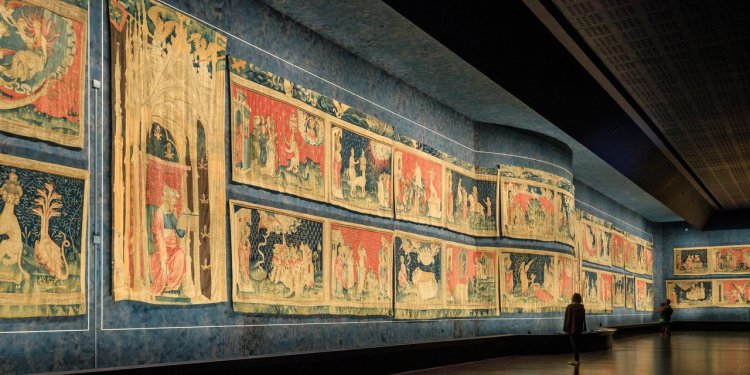The Apocalypse Tapestry: Biblical Visions Woven in Wool
Commissioned in France in the 14th century, the Apocalypse Tapestry’s revelatory depictions of demons and angels alike remain staggering in their scale and artistic detail The Apocalypse Tapestry, Angers, France Photo: Alamy Stock Photo By James Romm July 7, 2023 6:08 pm ET When Louis I, Duke of Anjou in late-14th-century France, commissioned a tapestry illustrating the Book of Revelation, the artist and weavers he hired must have quaked in their boots. That biblical text, a vision of the end of days recorded by a certain St. John, contains a welter of phantasmagorical images—not only the famous four horsemen but a beast with seven heads and 10 crowned horns, locusts with human faces and lions’ teeth, and allegories such as the “winepress of the wrath of God.” Artists before Louis’s time had portrayed individual scenes


The Apocalypse Tapestry, Angers, France
Photo: Alamy Stock Photo
When Louis I, Duke of Anjou in late-14th-century France, commissioned a tapestry illustrating the Book of Revelation, the artist and weavers he hired must have quaked in their boots. That biblical text, a vision of the end of days recorded by a certain St. John, contains a welter of phantasmagorical images—not only the famous four horsemen but a beast with seven heads and 10 crowned horns, locusts with human faces and lions’ teeth, and allegories such as the “winepress of the wrath of God.”
Artists before Louis’s time had portrayed individual scenes from Revelation, including a few on tapestry, a challenging medium. But the lord of Anjou, who ruled his duchy from a palace in the town of Angers, wanted a depiction of the entire text. Five years of work by illustrator Jean Bondol and the workshop of Robert Poinçon produced an image cycle that compares, in scale and breadth of vision, with the more famous biblical cycle later painted by Michelangelo on the Sistine Chapel ceiling.
The tapestry Louis received in 1382 was so vast that no single room in his chateau could accommodate it. Originally about 460 feet long and 20 feet high, the work proclaimed the wealth and magnificence of the house of Anjou on the rare occasions when it was displayed, perhaps in outdoor locales like festival grounds. Louis’s son and namesake had it exhibited during his wedding ceremonies in 1400; a guest who saw it then declared in a letter that “no man can write, or express the value, the beauty, the nobility of this tapestry.”
The Apocalypse Tapestry, as it is known today, inspires similar wonder in visitors to the Chateau of Angers, in the Loire valley, where extant portions are displayed in a gallery built in the 1950s. Sadly, about a third of the work was lost, and other parts damaged, during the centuries when it lay in the storerooms of the Angers cathedral. Disdained during the Enlightenment as a relic of medieval pietism, the tapestry furnished rags for stableboys and mats for wiping one’s feet, until it was rediscovered and restored in the mid-19th century. Its faded colors were renewed with fresh dye and holes were patched here and there by artisans using looms similar to those of its original creators.
The surviving 71 scenes, with alternating red and blue backgrounds, illustrate the portents that, in John’s vision, will herald the end of days. Stars fall from the sky, rivers turn to blood, cities collapse, and vile creatures stalk the earth. But the sufferings of humankind are watched over by angels of mercy and by God himself, depicted in cloud-wreathed insets that show us how heaven takes a hand in these hellish events. Ultimately the world is being guided toward the new Jerusalem, though the culmination of the story is among the lost portions of the original work.
As they make their way down the long, solemn gallery in Angers, visitors will marvel at the ingenuity with which abstract or symbolic ideas have been given pictorial form. Scene 52, for example, depicts the salvation of seven righteous men who reject false gospel. The corpses of the seven, bearded and wizened, are seen lying peacefully in two beds, while above them two angels carry their souls, depicted as smooth-cheeked children, in a sort of bunched-up sheet. With an effortless lift—for their souls have no weight—the angels bring them inside the wreath of clouds that forms a portal to eternal bliss.
Monsters and demons are perennial sources of fascination in medieval art, and the tapestry’s depictions of these, especially the orange-hued, seven-headed dragon that represents Satan, do not disappoint. But the mastery of the work’s artisans truly reveals itself in subtler effects: the huge array of plants and animals that dot its landscapes, for instance, or the constantly varied patterns, part floral and part geometric, superimposed on the red and blue backgrounds. The drapery folds in the robes of human and divine figures are as naturalistic as on the finest Greek marble sculptures.
To the left of each panel the tapestry’s creators have depicted John, the author of Revelation, witnessing the scenes he will later include in his book. He reacts in various ways as the drama unfolds, sometimes with shock and horror, other times with serene faith in the coming redemption. Angels point out to him things he must notice or unfold scrolls bearing messages he must record. The tapestry thus does not depict the Apocalypse itself but John’s transcription of what he had foreseen.
Unlike other artistic masterworks, the Apocalypse Tapestry is remarkably free of tourist crowds. When my wife brought me to see it on an afternoon in November, we found ourselves standing completely alone before this astonishing vision.
—Mr. Romm is professor of classics at Bard College.
What's Your Reaction?























